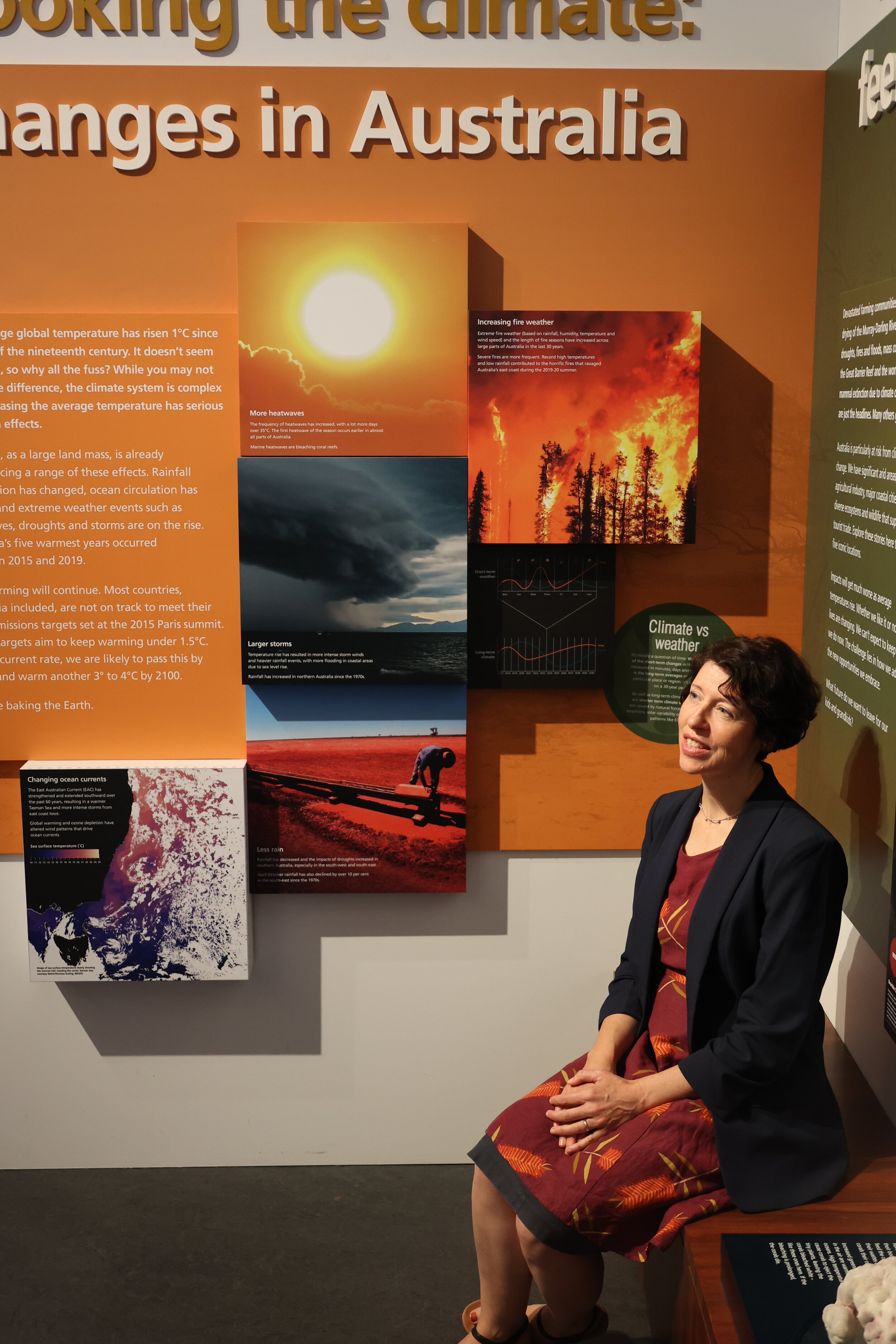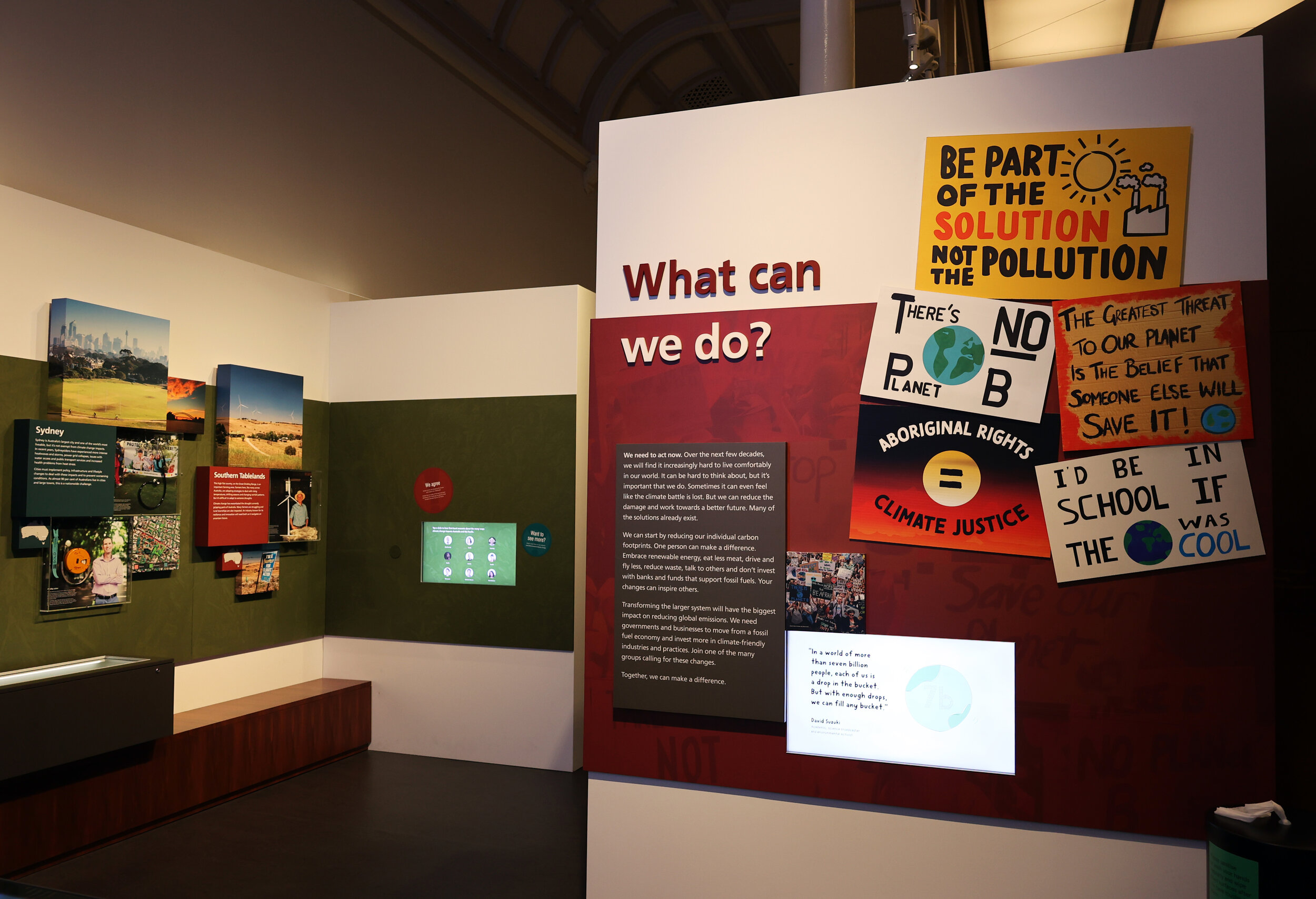Dr Jenny Newell
Gadigal Land | Words by Jenny Newell | Photos by Arielle Gamble
We caught up with Dr Jenny Newell, Manager of Climate Change Projects at the Australian Museum, to learn about her journey as one of our nation’s leading climate communicators, and the exhibitions the Museum has recently launched: – ‘Changing Climates’, and, just opened in the Museum’s main hall, ‘Spark: Australian innovations tackling climate change.’
Jenny sitting within the Garrigarrang exhibition at the Australian museum: exploring the rich cultures and spiritual traditions of the Salt Water People who call sea country home.
“I’m one person, but I can help. I think my superpower is bringing people together, whether it’s people in the Pacific who have so many important messages for the rest of us, or bringing people together to learn from each other around an exhibition or a story.”
Previously, after a public event at which some of our Pacific colleagues would talk about climate change impacts, people in the audience come up and say, "I had no idea. What can I do?" My goal, through the Museum, is to enable more people across Australia to recognise, first of all, that they are needed, now, to tackle climate change and better care for Country. I want them to recognise the many win-win solutions that are already there, and I want to help people discover their own answer to that “what can I do?” question.
The Australian Museum has taken on developing action on climate change and sustainability as a key priority. We are highlighting solutions to climate change, whether they be technological, or nature-based, or community-based.
In the Changing Climates and Spark exhibitions, I wanted to make sure we were telling human stories.
“ I think we need to see how climate change is impacting other people, often people like us, to feel it ourselves.”
For example, in this exhibition, Dr. Kim Lu talks about the health impacts in Sydney caused by burning fossil fuels, and how pollution and rising heat impacts her patients, particularly the young and the elderly.
Charlie Prell, a farmer of sheep and wind, also talks about what a great solution renewables have been for him and his community. The regular income from the wind turbines has been really important for the mental health of his own family, as well as some of the other families who work for him.
Through these exhibitions, online content, and our upcoming community outreach projects, the Australian Museum is saying , "Climate change is happening - it is serious - but you can get on board now to reduce it and help create a more biodiverse, healthier, cleaner, fairer future.”
Empathy is at the heart of everything. It’s what drives me, I guess. Anyone who's throwing themselves into the tackling climate change space is doing it because we care deeply about other people and other species.
Unless we are listening to the stories of everyday people talking about the changes they are experiencing in their environment and how their community is already responding, we're not going to get anywhere, we’re not going to be able to help people to take the conceptual leaps they need to connect to a more caring way of living with this country. A wonderful friend and colleague at the Natural History Museum in London, Camilla Tham, talks about an online, crowd-sourced project we’re working on as a project that ‘builds bridges of empathy.’ I love that image and it is a wonderful way to characterise the work of many of us in the climate arena in museums.
“It’s important for people to think more deeply about themselves connected to nature. We’re really hoping to try and help people see ways that they can step up to being environmental stewards for their homes and the places they love.”
My penny drop moment about the climate crisis was watching a superb film by Franny Armstrong, years ago, called ‘The Age of Stupid’. It’s about the age of fossil fuels. The premise is that the world is now flooded and the only person left is an archivist in an extremely tall archive - a museum housing the remaining documentation and treasures of human civilization. The archivist is looking back through old documentary footage (interviews and news items focused on a set of characters set in today’s world). He’s trying to figure out why we didn't save ourselves when we had the chance, when we knew it was going wrong. He wonders if maybe we thought we weren’t worth saving. It was such an arresting thought experiment.
After sitting through that film of course, knowing how much is worth saving, I decided I couldn’t just keep sitting back and expecting other people to step up to take action on climate change. I needed to just jump in. Because we need the Earth to still be habitable a few generations from now. I find species extinction really hard to bear. I want my kids to be able to have kids; for there to be a feasible future for them. I was an environmental historian by training - and a bit of an introvert - but I knew I needed to create a shift, leave my decades of expertise behind, get on the learning curve I needed to, connect to others already in the field, and start making a difference.
“So I keep making myself stand up, talk about these issues and make clear, through the many modes of communication we have available to us in museums, how essential, urgent and relatively easy it is to protect our life support system. ”
Museums are trusted sources of information. Working in a museum that brings together nature and culture, through collections and research and outreach, I am ideally positioned to reach people on solutions to the climate crisis and the biodiversity crisis. I’m collaborating with climate audience researchers, climate communications experts, First Nations advisors, climate scientists, research and development teams, businesses, educators, action groups, digital content designers, artists, young people and of course other museum workers, here in Sydney, nationally and internationally. We are developing more effective ways to engage the disengaged. My projects are now gearing up to move beyond the museum’s walls much more than before, in communities, listening and sharing stories of local solutions. This is to enable the building of connections, conversations and collective action. I want to do as much as I can, and museums are effective platforms. They are good places for powerful stories for creating positive futures.
Spark: Australian innovations tackling climate change
Australia has a long history of developing amazing ideas. From First Nations innovators to the inventors of Wi-Fi, our thinkers have led the way. And now, they're taking on one of our greatest challenges: climate change.
In this new showcase, learn about inventions and innovative approaches offering positive solutions to the climate crisis. See some of the technology and practices Australians are working on to reduce pollution, create affordable and clean energy, support the richness of plant and animal life, and ensure a livable future for all.
















